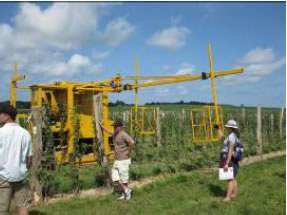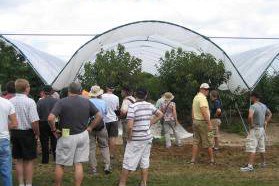July 28-30, 2010 in Geneva, NY
In late July, growers from North America and beyond boarded three coach buses in Rochester, New York for a pilgrimage to Mecca--Terrance Robinson's "Mecca of tall spindle apples," that is. In a tour lasting three days, Cornell Cooperative Extension guided the 2010 International Fruit Tree Association (IFTA) study tour of the western New York fruit industry focused on the tall spindle production system and the machines built for it. The tour stops included old and new tall spindle plantings, grower-built equipment and platforms, innovative high tunnels, and farm markets. The event had strong young grower participation--from stops hosted by first generation horticulturists, to the Young Fruit Growers of Lake Ontario who helped host the tours, and the several Young Grower Alliance (YGA) members who were in attendance.
For a day-by-day review of the study tour, check out the article below by YGA member Russell Holmberg!
Young Growers Join IFTA in Tour of Innovative NY Orchards
Russell Holmberg, Holmberg Orchards, Gales Ferry, Connecticut
In late July, growers from North America and beyond boarded three coach buses in Rochester, New York for a pilgrimage to Mecca--Terrance Robinson‟s "Mecca of tall spindle apples," that is. In a tour lasting three days, Cornell Cooperative Extension guided the 2010 International Fruit Tree Association (IFTA) study tour of the western New York fruit industry focused on the tall spindle production system and the machines built for it. The tour stops included old and new tall spindle plantings, grower-built equipment and platforms, innovative high tunnels, and farm markets. The event had strong young grower participation--from stops hosted by first generation horticulturists, to the Young Fruit Growers of Lake Ontario who helped host the tours, and the several Young Grower Alliance (YGA) members who were in attendance.
Day One: Tall Spindle Past and Present
The first day of travel began with a trip to Burch Orchards for a look at Cornell rootstock trials: The Good, the Bad and the Ugly. With well over 30 different rootstocks underneath „Honeycrisp‟, G935, G11, and G41 came out clear winners. From there the buses headed to Mike Zingler Orchards for a look at his new block of tall spindle trees. A first generation grower, Mike explained how he used new varieties, technologies like SmartSpray, and aggressive renovation to keep his 500+ acres in top shape. At Brown‟s Orchard and Berry Patch, Terrace Robinson walked the group through a five acre planting systems trial he set up with Steve Hoying in 1992. It was a great opportunity to see a dozen or more different types of plantings and spacings of mature trees, from central leader to V-trellis to super spindle. The tour continued to Brown‟s new pesticide storage and filling building, high tunnel raspberries, and on to their first-class farm market for lunch.
The afternoon tour began at Lamont Farms super spindle trees. Lamont‟s pristine orchards were planted tightly and were aggressively managed. Two unique aspects of their management included weekly, season-long small doses of fertilizer and detailed summer pruning that brings light into the fruit and decreases the width of the canopy considerably. The Lamonts also showed their recently acquired platform and tower sprayer. From the freshly planted trees of Lamont‟s, the tour continued to LynOaken Farms where Darryl Oakes showed his mature block of high density trees. With trees upwards of fifteen years old, Darryl‟s "old dogs" showed the group how his orchard had been successfully managed for the long term using the techniques advocated by Cornell Extension. Wednesday wrapped up with a trip to Singer Farms, where Jim Bittner explained how his unique climate and eagerness to experiment had allowed Singer Farms to grow stone fruits with success.
Day Two: Cornell Fruit Days
Day Two was spent at Cornell‟s experiment station looking at all aspects of their tree fruit research. In the morning, the group was shown Cornell‟s experimental blocks where research on plant physiology is conducted. Techniques are as radical as tenting entire trees with clear plastic to catch the gaseous exchange that occurs in various climatic conditions. Other stops in the morning tour included rootstock trials for fire blight resistance and a lesson on codling moth mating disruption. Terrance Robinson had two non-apple planting systems trials to show the group. The first was a mature planting that applied the tall spindle system to pears using various rootstocks, spacings, and cultivars. The results proved that pears could be easily adapted to the tall spindle system, as long as some care was taken when choosing the rootstock. The second planting systems trial was sweet cherries--grown outside, under rain cover, and in high tunnels. Planting systems included central leader, Spanish bush, and a hybrid vase technique involving six vertical shoots per tree. Key points that have been learned so far include the importance of planting on a berm for moisture control, thorough bacterial canker management, and proper cultivar selection for successful sweet cherry production in the Northeast.
The afternoon session brought an explanation of Cornell‟s breeding programs led by Susan Brown. Participants were shown how an apple goes from a cross, through the selection process, and into the orchards for trial. The breeding program has been under great expansion lately with hundreds of new acres dedicated to trials at the experiment station. It was also in the afternoon that the growers finally got to see Terrance Robinson‟s self-proclaimed "Mecca of the tall spindle." Robinson‟s "Mecca" was his planting trials where the tall spindle was refined and impeccably demonstrated at the Cornell orchards. Chemical management was covered in talks that included Andrew Landers on spray technology, Dave Rosenberger on DPA treatment, and Robin Bellinder with herbicide management. The day concluded with another look at rootstock trials presented by Terrance Robinson.
Day Three: Platforms and More

The third day of the tour offered a showcase of the many tools, techniques, and hardware developed by growers to facilitate the planting, maintenance, and harvesting of high density plantings. The first stop of the morning was Red Jacket Orchards, where the group was shown a large planting of plums, apricots, and cherries in high tunnels. Red Jacket markets most of their fruit in New York City and uses a customer-driven approach to choosing what to plant. The high tunnels are an attempt to overcome horticultural constraints and satisfy their demand for unique stone fruits. At Wafler and Fowler Orchards, the tour group was shown unique platforms built by the farmers themselves. Fowlers used a modified tree digger for a power plant with outriggers to service up to four rows in their orchard at a time. Waflers had an impressive array of machines, including hedgers, tractor mounted pruning platforms, bin haulers, and the latest invention--a pull behind picking platform that hopefully will have a patent and be on the market shortly. At Wafler‟s nursery the group was able to view their unique equipment for cultivation, spraying, and budding. They were also shown plant growth regulator trials that include Tiberon for branching.
After lunch on Sodus Bay, the buses departed for Furber farms and their mechanical peach thinner built to the USDA template. The stop included an explanation of the peach orchard training and a demo of the thinning machine as well as a demo of their picking and pruning platforms. The last stop of the tour was KC Farms, who had recently installed solar panels and wind turbines to offset the cost of cold storage and labor housing. They also showed the group an impressive planting of Knip-boom trees that had set the New York state record for a third year with cumulative production exceeding 1000 bushels per acre.
By the end of Day Three, all participants in the tour had a thorough understanding of the tall spindle production system used in New York--what worked and what didn‟t, how to modify it according to each grower‟s situation, and what rootstocks and cultivars to use and which to avoid. Most growers also have a wish-list of all the clever tools and toys they could build and put to use on their own farms.
Contact us

Social Media
Contact us



